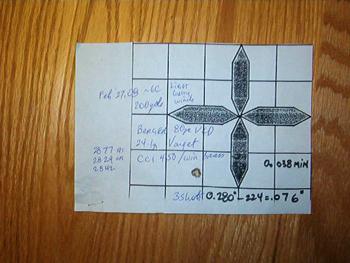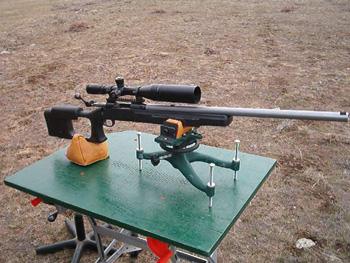Shooting A 223 Rifle To A Mile Accurately
By Jerry Teo
223 To A Mile
This long range 223 rifle project began last year after some very heated debates on a couple of shooting forums. The general consensus was that it is impossible, a huge waste of time and I was a little bit off my rocker.

Sounded like a nice challenge to me.
The quest is simple, can I get a 223 rifle using new high BC bullets to reach out to a mile (1760yds) AND arrive accurately (initial goal was 2MOA or less). Felt that hitting a 55 gallon drum sized target would be doable.
Dumping 223 bullets all over a hillside doesn't constitute much of anything except a huge waste of time and components.
Since I was going to build an 223 F(TR) rifle anyway, I figured this would be a fun addition to my rifle project. To add more spice to my quest, I wanted to do this as inexpensively as possible so others could have fun too.
As I have done in the past, the rifle is based on a Stevens 200 in 223. About as inexpensive an action as you can get that still has great accuracy potential. Just about everything was stripped off it except the recoil lug. The trigger group was replaced with a Rifle Basix 2 set at a few ounces.
The rifle stock is a Choate Ultimate Varminter I got off an exchange forum. The action was properly bedded which required some building up under the barrel nut. Ballast was added to the rear of the stock to improve balance. The forend was widened to help ride my pedestal rest bags better.
The 223 rifle barrel was a prethreaded, prechambered Pac Nor. The first barrel was a CM base match model with polygonal rifling. Didn't shoot too good and was off to a new home.
The second is a 223 SS Super Match, 5R, 7 twist 1" no taper 28" finished that has shot superbly in my 223 rifle. I am sure that an 8 twist and more conventional rifling would have worked just as well. This 5R barrel was in the inventory which sped up delivery.
The machining and chambering were very well done. No fancy smithing was done to the Stevens. I simply screwed the new 223 barrel on the rifle while working at my reloading bench. I knew that for long range work, the best accuracy was demanded. 1/2 min at 200yds was a minimum but less is always better. Vertical dispersion was also critical to get rid of. I was hoping for a 1/4 min vertical and 1/2 min horizontal - groups would look like sideways footballs.
Working with 80gr 223 Amax and Berger VLD's, I found that Varget, lit by CCI 450 primers, in Lee collet sized Win brass got the job done. At 200yds, the 223 Amax was hovering at 1/4min and the Bergers would get the occasional group MUCH less.
The smallest test load with the Bergers in my 223 rifle is also the smallest group I have ever shot at 200yds. Three rounds into 0.056". Yep, the barrel is a shooter.
I also tested 75gr Amax as this is a 223 bullet that many factory rifle barrels with a true 9 twist can stabilize. Savage/Stevens being the most popular.
Here is a pic on my portable, and slightly wobbly, bench. Please note the uphill angle of the rifle needed to reach out and up into the target hillside.

Once short range testing was done, the real rifle test began. How would these 223 bullets behave at distances where they would approach the transonic speed range?
The root to much of the criticism on this project is a belief that rifle bullets are most accurate/only accurate ABOVE the speed of sound. Once a bullet enters the transonic/subsonic speed range, it can experience some turbulence which disrupts its stability and causes it to diverge from the intended path, ie, it starts to tumble!
This can be graphically demonstrated by such bullets as the 168gr MK out of a 308. Does wonderful things our side of 1000yds. A rifle bullet with a long history of tumbling once it goes subsonic.
I will not get into the college math required but feedback from rocket scientists (they really are) on sites like benchrestcentral.com, have analyzed this topic with some super high tech equipment and tell us there is no transonic shock wave.
The bullet hits no wall or turbulence when it goes below the speed of sound. However, the aerodynamics of the rifle bullet does change as the air acts differently on the rifle bullet at slower speeds.
As a bullet slows down, the aerodynamic balance point of the bullet changes and some do become unstable. Others however, continue on their merry way without missing a beat.
Increasing the twist rate to increase spin stability is NOT a solution. They say that once a bullet leaves the muzzle with enough rotational stability to make it the first several hundred yards, it has more than enough to reach out beyond the speed of sound. In fact, the math suggests that spin stability actually increases as a bullet slows.
By Jerry Teo
223 To A Mile
This long range 223 rifle project began last year after some very heated debates on a couple of shooting forums. The general consensus was that it is impossible, a huge waste of time and I was a little bit off my rocker.

Sounded like a nice challenge to me.
The quest is simple, can I get a 223 rifle using new high BC bullets to reach out to a mile (1760yds) AND arrive accurately (initial goal was 2MOA or less). Felt that hitting a 55 gallon drum sized target would be doable.
Dumping 223 bullets all over a hillside doesn't constitute much of anything except a huge waste of time and components.
Since I was going to build an 223 F(TR) rifle anyway, I figured this would be a fun addition to my rifle project. To add more spice to my quest, I wanted to do this as inexpensively as possible so others could have fun too.
As I have done in the past, the rifle is based on a Stevens 200 in 223. About as inexpensive an action as you can get that still has great accuracy potential. Just about everything was stripped off it except the recoil lug. The trigger group was replaced with a Rifle Basix 2 set at a few ounces.
The rifle stock is a Choate Ultimate Varminter I got off an exchange forum. The action was properly bedded which required some building up under the barrel nut. Ballast was added to the rear of the stock to improve balance. The forend was widened to help ride my pedestal rest bags better.
The 223 rifle barrel was a prethreaded, prechambered Pac Nor. The first barrel was a CM base match model with polygonal rifling. Didn't shoot too good and was off to a new home.
The second is a 223 SS Super Match, 5R, 7 twist 1" no taper 28" finished that has shot superbly in my 223 rifle. I am sure that an 8 twist and more conventional rifling would have worked just as well. This 5R barrel was in the inventory which sped up delivery.
The machining and chambering were very well done. No fancy smithing was done to the Stevens. I simply screwed the new 223 barrel on the rifle while working at my reloading bench. I knew that for long range work, the best accuracy was demanded. 1/2 min at 200yds was a minimum but less is always better. Vertical dispersion was also critical to get rid of. I was hoping for a 1/4 min vertical and 1/2 min horizontal - groups would look like sideways footballs.
Working with 80gr 223 Amax and Berger VLD's, I found that Varget, lit by CCI 450 primers, in Lee collet sized Win brass got the job done. At 200yds, the 223 Amax was hovering at 1/4min and the Bergers would get the occasional group MUCH less.
The smallest test load with the Bergers in my 223 rifle is also the smallest group I have ever shot at 200yds. Three rounds into 0.056". Yep, the barrel is a shooter.
I also tested 75gr Amax as this is a 223 bullet that many factory rifle barrels with a true 9 twist can stabilize. Savage/Stevens being the most popular.
Here is a pic on my portable, and slightly wobbly, bench. Please note the uphill angle of the rifle needed to reach out and up into the target hillside.

Once short range testing was done, the real rifle test began. How would these 223 bullets behave at distances where they would approach the transonic speed range?
The root to much of the criticism on this project is a belief that rifle bullets are most accurate/only accurate ABOVE the speed of sound. Once a bullet enters the transonic/subsonic speed range, it can experience some turbulence which disrupts its stability and causes it to diverge from the intended path, ie, it starts to tumble!
This can be graphically demonstrated by such bullets as the 168gr MK out of a 308. Does wonderful things our side of 1000yds. A rifle bullet with a long history of tumbling once it goes subsonic.
I will not get into the college math required but feedback from rocket scientists (they really are) on sites like benchrestcentral.com, have analyzed this topic with some super high tech equipment and tell us there is no transonic shock wave.
The bullet hits no wall or turbulence when it goes below the speed of sound. However, the aerodynamics of the rifle bullet does change as the air acts differently on the rifle bullet at slower speeds.
As a bullet slows down, the aerodynamic balance point of the bullet changes and some do become unstable. Others however, continue on their merry way without missing a beat.
Increasing the twist rate to increase spin stability is NOT a solution. They say that once a bullet leaves the muzzle with enough rotational stability to make it the first several hundred yards, it has more than enough to reach out beyond the speed of sound. In fact, the math suggests that spin stability actually increases as a bullet slows.

